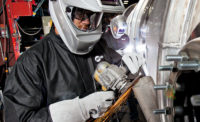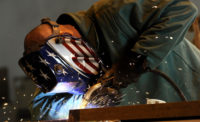
Health hazards associated with welding, cutting and grinding include eye and face impacts, arc radiation, inhalation of certain airborne contaminants, noise, heat stress, repetitive stress injuries, electrocution, fire and compressed gases. This article will focus on the first four, with an emphasis on eye and face protection and the personal protective equipment (PPE) available to reduce exposure to these hazards.
Eye and face impacts
The three categories of eye injuries are foreign body injuries, penetrating and blunt force injuries and arc radiation injuries from welding. Foreign body injuries are the most prevalent and are typically not directly related to welding, cutting or grinding operations. They tend to occur post operation when grinding chips, metal pieces or other small particles fall or are rubbed into the eye as other tasks are being performed.
Penetrating and blunt force eye injuries often result from a direct blow to the eye and eye area. All PPE eyewear designed in accordance with the ANSI Z87.1-2003 Occupational and Educational Personal Eye and Face Protection Devices must cover, at a minimum, the eye socket area of the majority of the population and are specified to reduce the chance of objects having a direct path to the eye.
Following safe work practices and selecting and wearing proper ANSI Z87 marked PPE are the best ways to help reduce overall eye and face injuries. Spectacles and goggles should protect the eye area from direct impact. Some goggles also provide additional protection from dust, mist and splash conditions.
Face shields are designed to cover the eye area but also to protect the face against certain flying objects. ANSI Z87.1 standard requires the use of spectacles as primary eye protection under all face shields and welding helmets so that when the shield or helmet is lifted up, the eyes are still covered.
To reduce the likelihood of metal chips and particles becoming entrapped in the hair or scalp, consider wearing a head covering that can be removed easily at the end of the day. When removing head coverings, individuals should take care to reduce potential fall-out of particles and should also take care while showering.
PPE that incorporates powered and supplied air options may be another means of reducing the number of eye injuries. These types of PPE cover a large portion of the user’s head and face and offer increased comfort by providing constant airflow across the head and face.
Arc radiation
Exposure to radiation from arc welding can occur when an individual’s eyes are exposed to the three types of direct or reflected light: visible, ultra-violet (UV) and infrared (IR).
While visible light is the portion of light that can easily be seen, harmful UV and IR light cannot be seen. Exposure can result in painful and immediate eye injuries known as “arc eye,” effectively a sunburn to the cornea. Multiple overexposures can cause cumulative injuries that, if left unprotected, can lead to permanent eye injury and blindness. In addition, constant exposure to UV light may cause skin damage contributing to the possibility of cancer and other skin conditions. Using sunblock with a SPF of 50 or greater may help reduce overexposure to UV light.
According to the ANSI Z87.1 standard, primary eye protection must be worn under all welding helmets. Primary eye protection constitutes Z87 or Z87+ marked safety spectacles or goggles that will effectively block most of the UV spectrum. Wearing safety spectacles under the welding helmet can significantly reduce UV eye damage even while the helmet is in the up position. Some specialty safety spectacles can also provide additional protection against IR light.
A quality auto-darkening welding helmet may help reduce eye injuries caused from arc radiation. Typically welders wearing an auto-darkening helmet leave the helmet in the “down” position more frequently than is the case with traditional passive welding helmets. This helps protect the eyes from stray and reflected arc radiation and also from flying objects that contribute to foreign body and blunt force eye injuries.
Inhalation of contaminants
Respiratory protection devices may be required in some welding, cutting and grinding processes that produce airborne contaminants in the form of particles, gases and vapors. Some examples of particles are metal fumes, dusts and mists; examples of gases and vapors include ozone, fluorides and shielding gases.
In welding, cutting and grinding applications, hexavalent chromium (CrVI) is one of the potential particulate exposures regulated by OSHA. In February, 2006, OSHA required affected employers to measure worker exposure and establish control measures accordingly. OSHA reduced the permissible exposure limit (PEL) from a value of 52ug/m3 to a value of 5ug/m3 or a drop in exposure limits by more than an order of magnitude. OSHA has given employers until May 31, 2010, to put engineering controls in place, and if that is not feasible, to develop an effective respiratory protection program.
In most cases, a N95 particulate filter will provide sufficient filtering for hexavalent chromium. Depending on the results of worker air sampling and exposures, a half facepiece respirator such as a disposable filtering facepiece respirator with an assigned protection factor (APF) of 10, or a powered or supplied air respiratory system providing an APF of 1000 may be required.
In addition to hexavalent chromium, other respiratory hazards may exist depending on the application or process. If air quality is in question, consult an industrial hygienist to perform a workplace assessment of your facility.
Noise
Welding, cutting and grinding processes can create noisy environments that require hearing conservation programs. The five required elements of OSHA’s Hearing Conservation Standard, 29 CFR 1910.95, are: noise monitoring, annual hearing testing, hearing protectors, annual training and record keeping.
Environments having a time-weighted average (TWA) greater than 85dBA require a hearing conservation program. If the TWA is greater than 90dBA, exposed workers must wear hearing protection to reduce the TWA to lower than 90dBA. Additionally, employers must provide a selection of hearing protection devices (two or more), to allow options regarding fit and comfort.
The best hearing protectors are worn correctly and consistently, have good fit and are comfortable. There are many types of hearing protection devices (HPDs) on the market ranging from disposable foam earplugs, reusable molded earplugs, banded devices and earmuffs with and without built-in communications. When selecting an HPD, consider the performance or noise reduction and attenuation of the device. Also consider the effect the HPD has on communications and whether it will cause any adverse safety concerns while being worn. Next consider the comfort of the HPD throughout the wearing period.
Ask the expert
Welding, cutting and grinding applications may create numerous health hazards. If in doubt, have a trained health and safety expert assess the situation to determine what hazards exist in a given process. Safe work practices, along with properly selected and worn PPE, can help reduce many of these potential risks.



